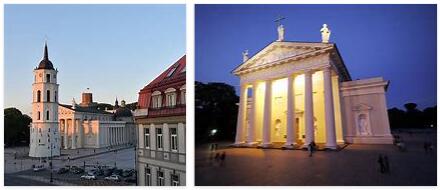Vilnius Cathedral
A monument of old times
Cathedral, Lithuania is a neoclassical archiepiscopal cathedral located on Cathedral Square of Vilnius Old Town with many different sights. The 18th century cathedral is a monument designed by the Lithuanian architect Laurynas Gucevicius. It stands on remains of foundations from the 13th and 14th centuries. The three statues on top of the church are by Karol Jelski, a famous painter, sculptor and plasterer. The original statues were destroyed during the occupation by the Soviets, but were recreated in 1997 by the sculptor Stanislovas Kuzma. The bell tower of Vilnius Cathedral is separate, as is the case with many Baltic churches.
Nobles, princes and bishops
The statue in the center of the Vilnius Cathedral shows Saint Helena with a large, gilded cross. St. Casimir stands to her left, and St. Stanislaus to her right. The most famous personalities of the Grand Duchy of Lithuania – including nobles, princes and church personalities – are buried in the catacombs of the church. Alexander, King of Poland and Grand Duke of Lithuania, rests in the mausoleum under the Casimir Chapel. Another essential element of the Vilnius Cathedral is the bell tower, which, as a vertically dominating object, is considered to be the symbol of Vilnius. Earlier – more precisely in the 13th century – the bell tower was part of the city’s defensive wall. Almost the entire first level of the bell tower has been preserved to this day. The bell tower of Vilnius Cathedral got its current appearance at the beginning of the 19th century. It measures 52 and 57 meters, respectively.
City tours and educational programs
A beautiful view of the city opens up from the bell tower, one of the oldest and tallest towers in Vilnius Old Town. Visitors to Vilnius will appreciate the city clock, bell exhibition, and reconstructed images of the cathedral and bell tower. Many different events such as guided tours of the city and educational programs are organized in the bell tower by the Museum of Ecclesiastical Heritage.
MO Museum
Vilnius is still a real insider tip for many tourists. But the number of international visitors to the capital of Lithuania is increasing. After all, it has a lot of attractions to offer. With the MO, the Museum of Modern Art, another attraction will be added in autumn that should not be missing on any tour of the city. The museum will officially open on October 18th. The “MO” is not only characterized by its valuable works of art from 1960, but also by its very special architecture. The ultra-modern building was designed by the American star architect Daniel Libeskind. The museum’s extensive collection offers over 4,500 paintings, photographs, sculptures or drawings by more than 200 different Lithuanian artists. The large sculpture garden is also extremely worth seeing. This is connected to a large roof terrace by a wide staircase. In addition to a large permanent exhibition, changing exhibitions are planned at regular intervals on the approximately 1,000 square meter exhibition area in the two exhibition halls of the museum. The 3,100 square meter “MO” is located near the medieval city center of Vilnius. In addition to the works of art, there is also a bookshop and a large café in the museum, which is well worth seeing. There is also a state-of-the-art event center in the museum building.
Curonian Spit
In aerial photographs it is no more than a line in front of the Lithuanian coast: the Curonian Spit. The elongated peninsula separates the lagoon from the Baltic Sea. At its narrowest point, the Curonian Spit measures just 380 meters. The 98 kilometer long peninsula is divided into a Lithuanian and a Russian part.
Flora and fauna
Most of the Curonian Spit consists of pine forests. Both Russia and Lithuania have declared the area a national park. On the Russian side are the highest sand dunes of the Curonian Spit. Because of the many dunes, the landscape is also called “Northern Sahara”.
The largest dune in Europe, the Great Dune, is located on the Curonian Spit near Nida. It measures 50 meters at the highest point. However, if you want to experience the dune in full size, you should plan a trip soon: in the last three decades it has shrunk by a good 25 meters.
Cultural landscape of the Curonian Spit
Not only the nature of the Curonian Spit is worth protecting; In 2000 the cultural landscape was declared a World Heritage Site by UNESCO. Many of the sights are located in the village of Nida, in English: Nidden. Nobel laureate in literature Thomas Mann spent many years in this village, working on some of his most important works. His holiday home is now a cultural center and museum and is therefore an important destination for study trips. The Hermann Blode Museum is also located in Nida with an exhibition room with details on well-known European personalities.
Anyone interested in Lithuanian mythology should take an excursion to the Witches Mountain near Joudkrante (Schwarzort). The path through the pine forest is adorned with wooden sculptures from Lithuanian legends. In addition, in the 19th century, huge amounts of amber carvings that were up to 4,000 years old were found in Juodkrante. However, many of the pieces of jewelry were lost in the turmoil of World War II.
